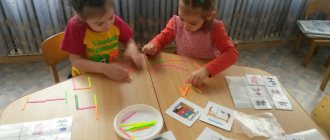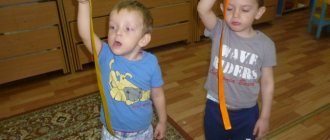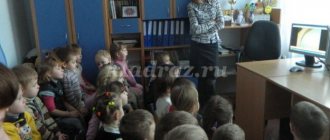content .. 10
11 12 ..
Education for labor activity in the second junior group of preschool educational institutions
In the 4th year of life, the child’s activity and purposefulness increase, and movements become more varied and coordinated. Children begin to master the ability to act, setting a goal, but due to instability of attention, they are still quickly distracted and move from one thing to another. In younger groups, the main task is to develop independence and a positive attitude towards work. A three-year-old child has an inherent desire to act independently. “I myself!” - he declares, often not realizing his capabilities. Self-care occupies a large place in the work activities of children of the 4th year of life. When organizing the work of children, teaching them self-service skills, it is important not to suppress the desire for independence; this is a great “conquest” of a three-year-old child, the most important factor in the formation of his hard work. Great patience and pedagogical tact are required from the teacher, so as not only not to extinguish the children's initiative, but also to promote its development. As in the previous group, play techniques are of decisive importance, since they allow the teacher, on the one hand, to hide his pedagogical position, and on the other, to more actively influence the child. So, a teacher can bring a large doll into the group and say that she came to visit the kids by train and will now live with them. Children get acquainted with the toy, assign it a closet in the dressing room, together with the teacher they install a crib in the bedroom, assign a place at the table in the doll corner, etc. They then teach the doll self-care skills, and the doll evaluates their actions. A positive assessment by an adult of even small successes of a child causes satisfaction in the child and gives rise to confidence in his abilities. This is especially important to remember when communicating with shy and timid children. In relation to a spoiled child who has a tendency to be arrogant, encouragement should be used carefully. It is important to encourage children to help each other, using the example of those who have already developed certain skills, to teach them to be attentive and kind to each other. But this technique should be used carefully so that the child does not get used to constant help. The formation in a child of a need to participate in work that is feasible for him is facilitated by nurturing in the child an interest in the work activities of adults. Giving kids a basic understanding of the work of a nanny, janitor, driver, cook, nurse, you need to draw their attention to the conscientious attitude of adults to work (they work for everyone, diligently, carefully, quickly). During the observation process, children should be drawn to the labor operations performed by adults (the nanny soaked a rag in water, wrung it out, wiped the shelf, rinsed the rag, wrung it out again, etc.), and examine with them the materials and equipment that are used in the work. It is necessary to emphasize the final result of the work (the nanny washed the shelf and it became clean). Thus, the child develops the idea that the basis of each specific labor process is the satisfaction of one or another human need. The formation of these concepts is also served by such a technique as creating situations that encourage children to act. For example, having learned that the kids want to take the doll Nastya with them for a walk, the teacher draws their attention to the fact that Nastya does not have tights, a hat or scarf and it is cold outside. Leads them to the idea that they need to sew the missing clothes. In the presence of the students in the evening or the next day, the teacher sews the necessary things for the doll, and they carefully observe, waiting for the result of the work (what will happen, what will happen). Finally, the hat is ready, the children immediately put it on the doll and take Nastya with them for a walk. It turns out that there was so much snow on the site that it was impossible to get to the veranda. What should I do? It’s impossible to do without Uncle Vasya, the janitor. A janitor came with a scraper and “with the help of the children” cleared the path to the veranda. It is on the basis of such specific impressions that the child begins to form ideas about a person’s work activity, develops a positive attitude towards the work of adults, and a desire to take part in it as much as possible. Household work is always aimed at caring for others. That is why it is so important to introduce children to it as early as possible. Household work in this group, just like in the previous one, mainly comes down to children performing simple individual tasks. The content of the work is not complicated - these are individual actions that the child performs at first together with an adult. For example, children, together with the janitor, remove leaves from the area, and together with the nanny, wipe down shelves and chairs. And even though their work is quite insignificant (and sometimes kids only interfere with an adult’s work), it should be encouraged in every possible way, since it contains the beginnings of collective work and helps to foster respect and respect for the work of adults. It is necessary that the work be feasible for children. However, already at this age the child should feel that all work involves overcoming certain difficulties. Only by making some effort will the baby feel the joy of his work. It is also important that this work ends with a clear result. Then the children realize its significance and necessity (“It’s good that Vova cleared the snow from the bench, we can now sit on it”; “Irochka wiped the table, now we can draw on it,” etc.). During the day, the teacher must find a necessary and useful activity for each child. You can give the same task to several children at the same time, for example, to wipe chairs (each child wipes his own chair). This is the very first stage of collective work - work nearby. From the second half of the year, children begin to be taught the skills of canteen duty. They are prepared for this gradually, starting with the previous group. Through assignments, the child gradually develops the ability to perform several labor actions related to setting the table. For example, first he is taught to place napkin holders and bread bins on the table, then lay out spoons. After the baby masters these actions, he is taught to arrange the plates. At the initial stages of instilling duty skills, techniques such as setting tables with the child are used, later with a little help from the teacher, as well as didactic games “Let’s set the table for dolls”, “Birthday of a bear”, etc. Children are on duty at those tables, behind which they sit. The work of each person on duty should be evaluated. Considering the age of the children, it is better to use a playful technique in the assessment. For example, the bunny says: “I don’t like the way Sasha, Olya and Vova were on duty today - they worked slowly, took each other’s spoons, and set the table ugly. I won’t sit at their tables, but I’ll sit at the tables that Sveta and Tanya set.” It is necessary to cultivate in children the ability to notice disorder in the environment. The group room should always be clean and tidy. You should talk to children in a friendly tone. Seeing that children have scattered toys, the teacher can turn to them with the words: Well, now let’s get down to business together - We need to put away the toys! Labor in nature. By instilling in children a love of work, the teacher tries to make them want to work in a corner of nature and on the site. In the fall, observations are organized of the older children harvesting vegetables in the garden, and the kids performing certain tasks (for example, with the help of a teacher, collecting dry leaves on the site, loading them into large toy trucks and taking them to a specified place). If the teacher himself is truly passionate about his work, the children will want to help him. With the onset of spring, you should monitor the pruning of trees and shrubs, planting flowers in the area, and digging up the garden. This helps to interest children in working in nature, making them want to plant or sow something themselves. On a group plot (or near it in a flat, sunny place) in the presence of children, you need to plant a vegetable garden (2-3 beds). The kids watch as the teacher digs up the earth with a large shovel and makes even beds and paths. You can invite them to stand one after another and, slowly moving along the bed, trample the path. “This is how smooth the path turned out to be. We will walk along it, and we will grow vegetables in the beds. You can’t walk on the beds,” explains the teacher. With its help, children plant onions in the beds and sow large vegetable seeds (beans, peas, beans). A white cord should be placed along the entire length of the bed (in the center). Children stand on both sides. Each child places (down to the cord) seeds (one at a time) into grooves prepared in advance by the teacher. The teacher fills the furrows and waters them. “Now our seeds will grow in the warmth, we will water them with water and such delicious beans will grow,” says the teacher and shows the picture. He puts it on the garden bed. In one of the beds, the teacher can sow radish or turnip seeds in the presence of children. Children are also involved in sowing large seeds of flowering plants (ornamental beans, garden beans, echinocystis (“hedgehog cucumber”). All work on caring for plants should be carried out in the presence of children, involving them in all possible participation. Weeding, loosening, fertilizing is done by the teacher alone , showing and telling the children what he is doing. In the summer, observations continue of the work of older children in caring for the plants of the vegetable garden and flower garden (watering, weeding and loosening the beds, flower beds, harvesting vegetables and fruits). You can organize the collection of grown vegetables, examine them, remember how they planted bulbs, sowed the seeds of peas and beans. The children take the harvested crops to the kitchen on toy cars and carts. While caring for the plants and animals of a corner of nature in the morning, the teacher shows and explains to the children what he is doing and why, attracts them to participate as much as possible. Children can water the plants, wipe the dust from large leaves (with the help of the teacher). Wiping the leaf with a damp cloth, the teacher says: “We carefully wipe the leaf so that it does not break. That's how beautiful and shiny he has become! And now you, Natasha, take the sheet in your palm like this, and take a rag in your right hand. Wipe carefully." Periodically - approximately once every 2 weeks, it is necessary to partially change the water in the aquarium in the presence of children. To make it more convenient for children to observe, they are seated in a semicircle. You can invite them to pour out the water in a mug. Children should be involved in planting onions and sowing large seeds of ornamental plants in a corner of nature. In the process of all types of work, special attention should be paid to instilling in children the skills of cultural behavior, humane feelings and positive relationships. Using encouragement and reminders, the teacher teaches them to thank them for the gratitude they have shown"), to express their request in words (“Ask Anna Ivanovna for a rag, Olya”). Children develop basic skills of organized behavior (don’t interfere with each other’s work, don’t make noise, don’t distract, don’t push, if necessary, step aside, make room, help a friend). It is important to organize the work of children nearby: collect pebbles in one bucket, wipe the leaves of one plant together, sow vegetable seeds in the garden, etc.; develop the ability to work together. For these purposes, in addition to the techniques described above, you can use performances. For example, after the kids watch a tabletop puppet theater performance based on the fairy tale “Turnip,” the teacher asks: “Who planted the turnip? Who helped grandfather? Leads the children to the conclusion: “Everyone tried! So we were all able to pull out the turnip together!” It must be remembered that children become kinder thanks to a kind, friendly word. “Our Svetochka is kind, like the sun in spring,” the teacher evaluates the child’s action, using a Russian folk proverb. To cultivate kindness, friendliness, and responsiveness, such techniques as an adult’s personal example, stories on ethical topics (“How one boy in a neighboring kindergarten helped his friend take care of a plant,” etc.) are used.
content .. 10
11 12 ..






